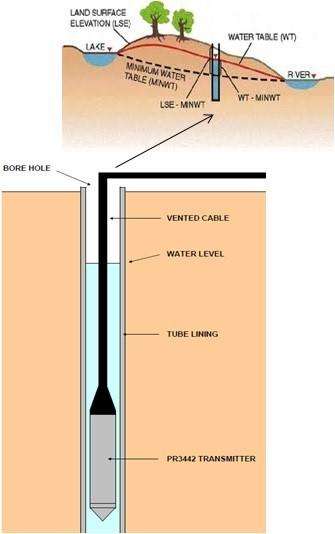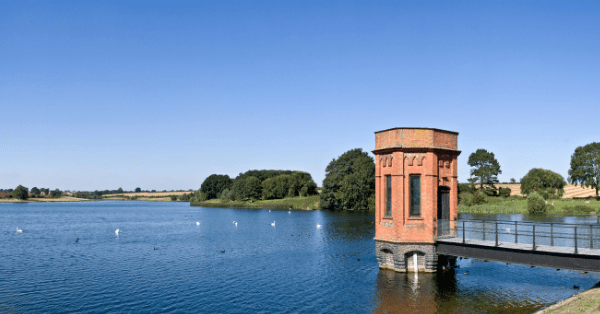Hydrostatic Level Measurement
One of the most common elements of process automation and environmental applications, such as hydrographic surveys, is the measurement of the amount of a liquid that may be present.
There are many liquid level measurement technologies available. Not all of which will be appropriate for your application.
ADM Instrument Engineering has decades of experience in this field and a white paper is available for download from the ADM website. This discusses what Hydrostatic pressure is, how Hydrostatic level measurement technology works, typical applications it is suited to, some examples of where it could be used and how it compares to other technologies.
ADM distributes hydrostatic liquid level sensors manufactured by ESI Technologies Ltd and Transducer Sensors Australia (TSA). These sensors are typically gauge reference and calibrated to 1 atmosphere.
Hydrostatic Sensors
Hydrostatic sensors are powered by a permanently fitted vented cable and is submerged into the liquid to be monitored.
In most applications the liquid surface is subjected to atmospheric pressure.
Compensation for barometric pressure change is achieved using a vented cable.

A vented cable is required because; in order to provide accurate electrical measurement it is important that the sensor element is subjected to the same atmospheric pressure as that acting on the liquid.
This is particularly important for the measurement of low levels of liquid, where changes in barometric pressure can significantly affect the true reading of level. For example, at high altitude where low atmospheric pressure is present.
The liquid column above the pressure sensor creates a hydrostatic pressure which is a direct indicator for the liquid level.
The liquid level sensor converts the acting pressure into an electrical signal. Most users will typically require a 4-20mA output, enabling signals to be transmitted over long distances, although other output options are available.
Calibration of Hydrostatic Liquid Level Sensors
ESI can calibrate and label sensors in units of measure determined by particular applications. For example in a diesel tank application the sensor can be calibrated in meters of diesel.
Borehole Monitoring
One advantage of hydrostatic level sensors is that they can be permanently immersed in boreholes.
For example, for measuring the depth of the water table.
The water table is the underground depth at which the ground is totally saturated.

Deep boreholes with an average diameter of 25mm are drilled and left to fill to the level of the water table. A small diameter submersible pressure sensor is lowered down the borehole to accurately measure this level. In this type of application the control system would normally incorporate a barometric sensor, which is used to compensate for changes in atmospheric pressure.
Hydrostatic Level Sensors for Hazardous Areas
IECEx certified ESI sensors are available that can be used in similar circumstances, but where there is a risk of explosion. For example, monitoring the water levels in coal seam gas wells. Cable can be supplied in continuous lengths of up to 500m.
Liquid Level Sensors for Storage Tanks
ESI Hydrostatic Level sensors are also well suited to measuring the levels of fluids in storage tanks. The pressure existing at a certain depth within a liquid is directly proportional to the column of water above.
Therefore, the level of the liquid in the tank is determined by using a Hydrostatic level sensor to take a reading at the bottom of the water column. The sensor is lowered to the bottom of the tank via an access hole in its top. The sensor cable is then connected back to a monitor, data logger, or PLC.

The advantages of using an ESI Hydrostatic level measurement sensor are that the vessel does not need to be disturbed or adapted to fit a level sensor. There is no need to install tank wells or sight glasses, etc. It allows levels to be measured under difficult conditions, such as down a deep shaft. The probe is easily retracted for cleaning and maintenance purposes. It is a highly reliable and robust solution.
Hydrostatic Fuel Level
Level measurement of liquids in bulk fuel storage tanks, such as diesel is required to avoid the overfilling of the tank, which could result in a spillage, and to avoid running out of fuel.
Diesel liquid has lower SG (specific gravity) than water, which is why it floats on top of water if they are ever mixed. The pressure at the bottom of a diesel tank will be less than the pressure at the bottom of the same level tank of water.
The specific gravity of water is approximately 1, whereas the specific gravity of Diesel is approximately 0.83.
Therefore, a 4-20mA output hydrostatic level sensor scaled for 0-1 mWG (Meter Water Gauge) would only give a 20mA output when submerged into 1.2m of Diesel.
The TSA range of hydrostatic level sensors conveniently show both scales on the datasheets
Hydrostatic Liquid Level measurement in Agriculture
Water is one of the most precious commodities on Australian farms, and level are monitored wherever possible.
These applications are not as mission critical as with other industries, and due to the high volumes it is important to have a fit for purpose solution that also meets the budget of a farm application.
ADM recommends the TSA hydrostatic liquid level level sensors, as they are economical enough to be used on all dams reservoirs and tanks around the farm.
Other Hydrostatic level Applications
As well as being used for permanent immersion in storage tanks, process tank and boreholes, hydrostatic pressure sensors can also be used for monitoring water levels in rivers or reservoirs.
Models are available in a variety of types with different diameters, materials, fittings and accessories.

Other technologies
There are many other technologies available that are promoted to measure the level of liquids in storage or environmental situations.
Ultrasonic: Non-contact, sound reflecting technology. It is expensive and time consuming to install. It can be adversely affected by foam, temperature and moisture. It is more suited to sensing solid media types.
Radar: This is a non-contact, microwave reflecting technology. Again it is expensive and time consuming to install. Is suitable for some specific applications such a molten steel. It is not affected by high temperature and moisture. This technology is commonly used in collision avoidance applications to protect equipment.
Capacitance: Uses probe or sensors that measure the conductivity of the medium present. Is suitable for liquids, solids and slurries at high temperatures. Is not affected by top vacuum pressure. Its use can be restricted in deep level measurement applications. It needs to be calibrated or tuned to media type.
Float: Mechanical and magnetic versions exist. It is suitable to control switching levels. Its scope is somewhat restricted, especially with viscous media types that can adhere to the mechanical sensing devices and adversely affect their function. Mechanical devices are also more prone to failure than non-mechanical devices.
Contact ADM Instrument Engineering for further information.
IS THIS INFORMATION USEFUL?
If so, why not share it with your peers and colleagues. Simply click on the blue LinkedIn share icon below.



